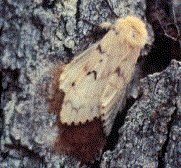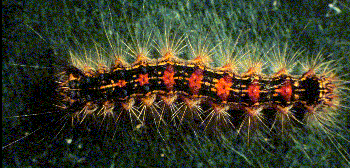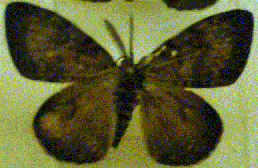





The three stages of the gypsy moth life cycle of which concerned citizens are commonly aware are the egg mass, the larva and the adult male. The adult female is more rarely seen because when it emerges from its pupa in the crotch of a tree limb it remains close to the pupal caste and starts emitting a pheromone which drifts with the breeze downwind signaling males that there is a female upwind ready to mate. The stage which is most frequently monitored by North American county, state and federal agencies is the adult male, which can be lured during its mating flight to a trap using an artificial female pheromone, GYPLURE. Tens of thousands of these pheromone traps are set each summer. The traps call gypsy moth males from large distances, trapping them and providing population biologists inexpensive estimates of the surrounding gypsy moth population size. It would be convenient if this cheap, effective and well established monitoring program could be used to help us to recognise when a foreign gypsy moth has entered our North American population.
Unfortunately, the males of the Asian, European and North American populations are superficially indistinguishable. We are therefore unable to use trap data for easily assessing the degree of the problem of incursion of the flying form of the gypsy moth female into our North American population.
Projects are underway to allow the discrimination of the genetic origin of a male gypsy moth using molecular biological approaches. These approaches may need to be applied to the thousands of males trapped by local programs trying to contain the spread of the Asian gypsy moth. We have developed a technique that allows discrimination of Asian and European males from North American male gypsy moths based on wing venation. This technique may be a cost effective way of pre-screening the thousands of samples of male gypsy moths that may need to be analysed. If a male wing is identified as potentially of Asian or European stock, it could be sent to be analysed by the more difinitive molecular biological screening procedures.
We accomplish our goal by applying discriminant function analysis to wing landmarks. We have established a database of expected wing landmark variability for several North American, European and Asian populations. A male Gypsy moth forewing of unknown origin is compared to this database and the wing obtains a discriminant score assessing its likelihood of belonging to one of the three origins we can recognise: North America, Europe or Asia. A higher score for membership in one of the foreign databases marks a wing as being of potential foreign origin.
The above approach uses established statistical concepts on a relatively new type of morphological data, landmark coordinates. While landmark coordinates have become a popular subject in the community of biologists interested in biological shape, our application of this approach is one of the first cases in which it is being used to solve a practical problem. We need to explain the general approach starting with its theoretical basis in order to make it acceptable and, moreover, the method of choice in this arena of applied technology. We also need to show examples of how this approach successfully discriminates foreign gypsy moths from native gypsy moths.
Become knowledgeable of the gypsy moth problem and cooperate with local authorities in the diverse programs aimed at controlling the gypsy moth in your area. Visit the Gypsy Moth Home Page. If you think it is warranted, educate your local legislators to the need for further research to solve these problems.
We need to upgrade our gypsy moth database with more specific populations of gypsy moths. If you have access to collections of male gypsy moths in your area, please contact our project to explore the possibility of inclusion of your samples in our study. See how fast we can add your population to the wing shape phenetic tree described above! We are particularly interested in European and Asian populations but North American populations from other gypsy moth strongholds in the USA, from the advancing fringe away from the Northeast United States and isolated populations from the Northwest United States are also needed.
If you have questions or potential contributions to our Gypsy Moth Discrimination Project, you can send an email message or snailmail message to Joe Kunkel, Biology Department, University of Massachusetts, Amherst MA 01003.